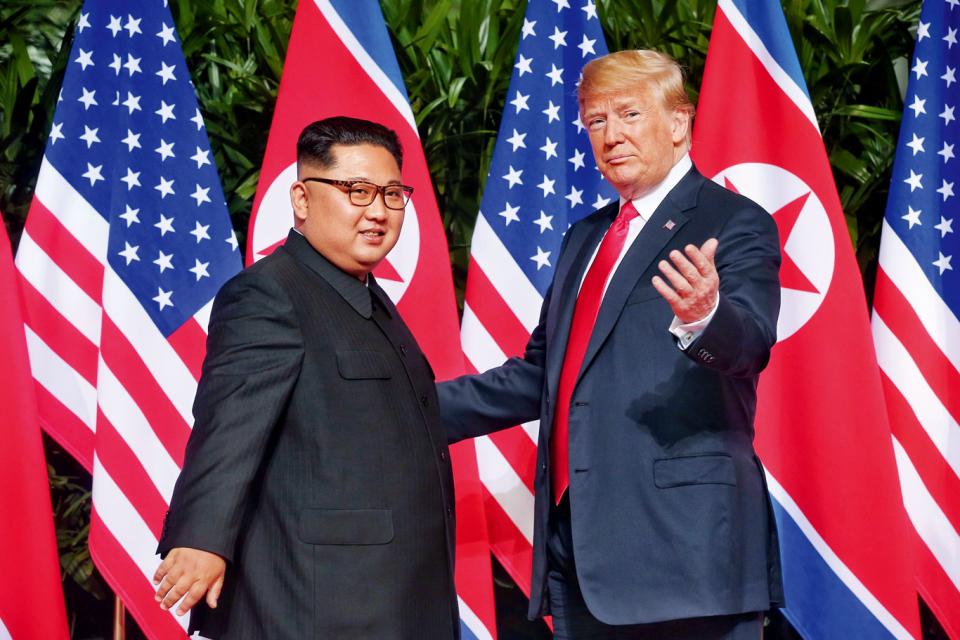In the luxury Capella Hotel on Sentosa, at 9:04am local time, Kim, wearing his black uniform, horn-rimmed spectacles and maintaining his trademark short back and sides haircut, in what was obviously a highly choreographed meeting, strode to greet Trump, who walked toward him wearing his usual dark suit and slightly too-long red tie.
“Nice to meet you, Mr. President,” Kim greeted Trump in English. They grasped each other’s hands firmly for 12 seconds. Behind them, the national flags of the US and North Korea hung together for the first time in history as their two leaders met.
The two leaders started their summit with a one-on-one meeting, joined only by two interpreters. After the personal meeting, which lasted 38 minutes, the two leaders emerged, strolling side-by-side through the grounds of the five-star hotel.
“I think the entire world is watching this moment. Many people in the world will think of this as a scene of fantasy… from a science fiction movie,” Kim told Trump through a translator.
Asked by a reporter how the meeting was going, Trump said: “Very good. Very, very good. Good relationship.”
The two leaders then joined in bilateral talks with their respective delegates before a working lunch. The menu featured a mix of Western and Korean dishes, including beef short rib confit, Korean stuffed cucumber, sweet and sour crispy pork with Yangzhou fried rice, and daegu jorim, Korean soy-braised cod.
After lunch, Trump and Kim walked alone through the grounds of the Cappella. Journalists waiting in the press area continuously lobbed questions. Kim smiled but did not answer. Trump said that the results of the meeting were better than anyone expected.
The summit culminated with the signing of a joint agreement, which asserted that the US president would provide “security guarantees” to Kim in exchange for North Korea’s “unwavering commitment to complete denuclearization of the Korean Peninsula.”
The statement also assured that both countries would establish “new relations” in the pursuit of “peace and prosperity,” and that North Korea would work toward “complete denuclearization of the Korean Peninsula.” The statement included the commitment that the remains of US soldiers missing in action and presumed dead from the Korean War would be repatriated to the US.
But there was no mention of the previous US aim of “complete, verifiable, and irreversible dismantlement” (CVID), a longstanding demand of the Trump administration. Kim’s commitment did not go beyond what he had already pledged to do in April when he met South Korean President Moon Jae-in.
Both sides have committed to future talks, which would be led on the US side by Secretary of State Mike Pompeo.Trump, after the summit, held a lengthy press conference detailing his discussions with the North Korean leader. The US President described the meeting as “honest, direct, and productive.” He revealed that the North Korean leader had already agreed to destroy a missile engine test site.
Trump then sent shockwaves through his own military and Moon’s administration by pledging to end the joint US-South Korean military exercises. He called the exercises “very provocative,” echoing the rhetoric North Korea uses in its propaganda, and “tremendously expensive.” He also mentioned the possibility of one day pulling out the 32,000 American troops stationed in South Korea.
Trump saw the summit as “a great moment” in the history of the world, and was buoyant about the prospects of peace on the Korean Peninsula. “We can honor the sacrifice of our forefathers by replacing the horrors of battle with the blessings of peace,” he said.

 Old Version
Old Version